Tango Luna, a stop motion short by Blake Douglas Young, 4:30 min, HD Video, 2019.
A dark and lyrical stop motion animation, Tango Luna features wild dogs, a cold-blooded mob, a spotlit tango dance, and a woman resisting the social conventions of 1930’s Europe. This allegorical tale in two acts tracks the emotional reaction of Magdalena Claudel as she stumbles upon a horrific scene in a city square, bearing witness to the passive cruelty of a crowd of onlookers. In the following act, responding to this savage spectacle, she performs a tango dance that rewrites the patriarchal power dynamic between female and male.
EVERYTHING TICKETY-BOO
Everything Tickety-boo, a stop motion short by Blake Douglas Young, 7:30 min, HD Video, 2014.
Tick•et•y-boo | tikitē ˈbo͞o | adj. [predic.] British informal dated. in good order; fine: everything is tickety-boo
"In mourning it is the world which has become poor and empty; in melancholia it is the ego itself."
-Sigmund Freud, Mourning and Melancholia
A ghost story, a fairy tale, a vaudevillian farce: Everything Tickety-boo is a dark yet jocular allegory for the psychology of grief. It depicts a young man’s fracturing identity as he begins to confuse external and internal realities. Protesting his entrapment in a dark wood, he compels himself to act out a series of bizarre calisthenics. His dance-like movements--akin to an incantation--summon to life a doppelganger, avatar or other. Feeling vacant and disconnected from his previous existence, he recognizes the opportunity to transfer the task of living onto this sudden apparition. His replica will inconspicuously take his place in the material world, from which the young man has retreated.
OUR LADY DIVINE
Our Lady Divine, 8:51 minutes, 2011
Pre-production Sketches and Design for Our Lady Divine
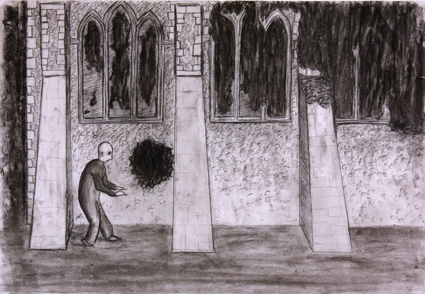
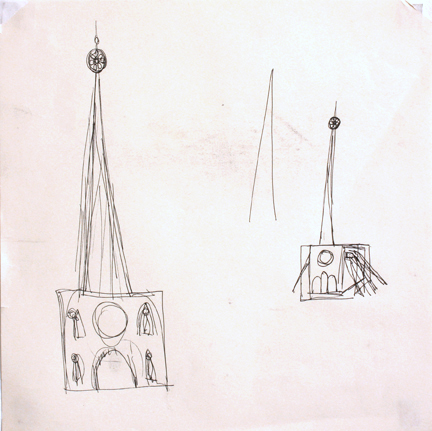
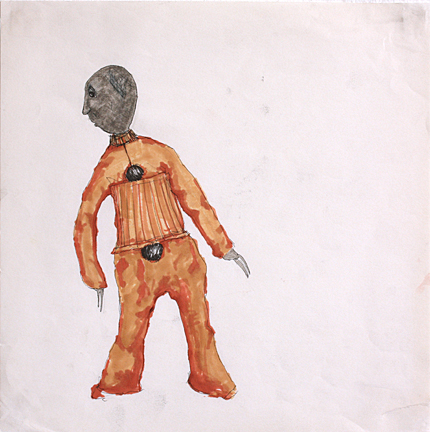


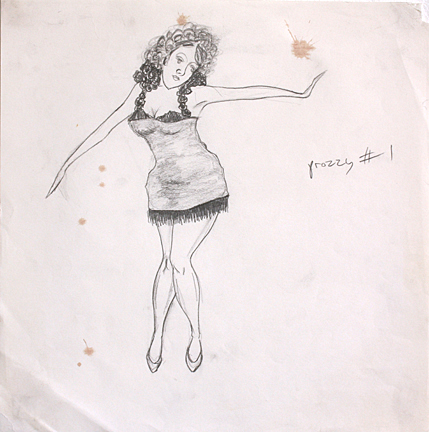




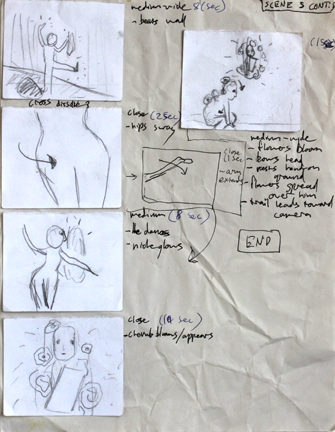
AUGUSTINE
Augustine, 1:30 minutes, 2011
HELLO JOHNNY
hello johnny, 3 minutes, 2011
Hello Johnny, (Blake Young, 2010, Los Angeles) is a three-minute experimental narrative employing stop motion shooting techniques and using found footage from The Bullfighter and the Lady (Budd Boetticher, 1951, Mexico/Los Angeles). The selected scene features four men (Johnny, Manolo, Antonio, Pepe), and is set in a steamy bathhouse. By re-editing and manipulating the shots, Young reveals an unrequited love story between Johnny and Antonio.
In most of the shots, the gaze between Johnny and Antonio is mediated by superimposed screens, cropping, inkblots, or flicker; the key exception is two reverse-angle shots, in which the two men exist alone within the frame without visible obstacles between them. They stare at one another as though paralyzed before a mirror image. The two men are not inhibited by desire but by a sudden self-reflexive awareness of placing their masculine identity in jeopardy. In the final scene, an enraged bull charges a matador that vanishes behind a wall. Wounded, isolated and impotent, the iconic bull’s fury parallels the psychology of Anthony and Johnny. As each man searches for himself in the other’s face, what he sees instead of the reassuring acceptance of the other, are his own fears staring back at him.
The original footage was projected on milk and re-photographed frame by frame with a still camera; this stop motion technique made it possible to animate reflections, textures, architectural shadows and black ink on the milk’s surface. The sound was recorded to echo the formal process of animating milk.
SAVE DRAFT
Save Draft, 3 minutes, 2011